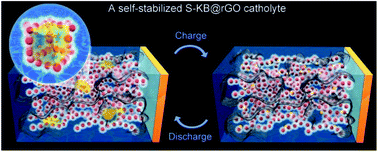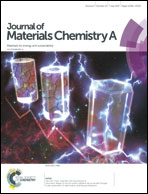A self-stabilized suspension catholyte to enable long-term stable Li–S flow batteries†
Abstract
Lithium–sulfur suspension flow batteries are a promising technology for large-scale energy storage, but long-term stability of the suspension catholyte is urgently needed for future application of this system. Here a special self-stabilized suspension catholyte is designed and prepared based on a pie-structured sulfur-Ketjenblack@reduced graphene oxide (S-KB@rGO) composite. In the S-KB@rGO suspension, the sulfur nanoparticles are loaded onto the conductive KB by an in situ redox reaction; the special hyperbranched structure of KB enhances the stability of the suspension; rGO sheets which wrap the S-KB particles not only act as a multilayered physical barrier for sulfur immobilization, but also facilitate electron transportation in the whole suspension. Therefore, a suspension catholyte with long-term physical and electrochemical stability is achieved by the synergetic effect of the KB and rGO. Li–S flow cells with this catholyte show excellent cycle stability (more than 1000 cycles with 99% coulombic efficiency) and low self-discharge (1.1% loss per day). Continuous charge/discharge tests in different flow modes are performed and the influence of the flow rate on the flow battery performance is discussed. The smooth operation in long-lasting flow mode further demonstrates the stability of the suspension catholyte.



 Please wait while we load your content...
Please wait while we load your content...